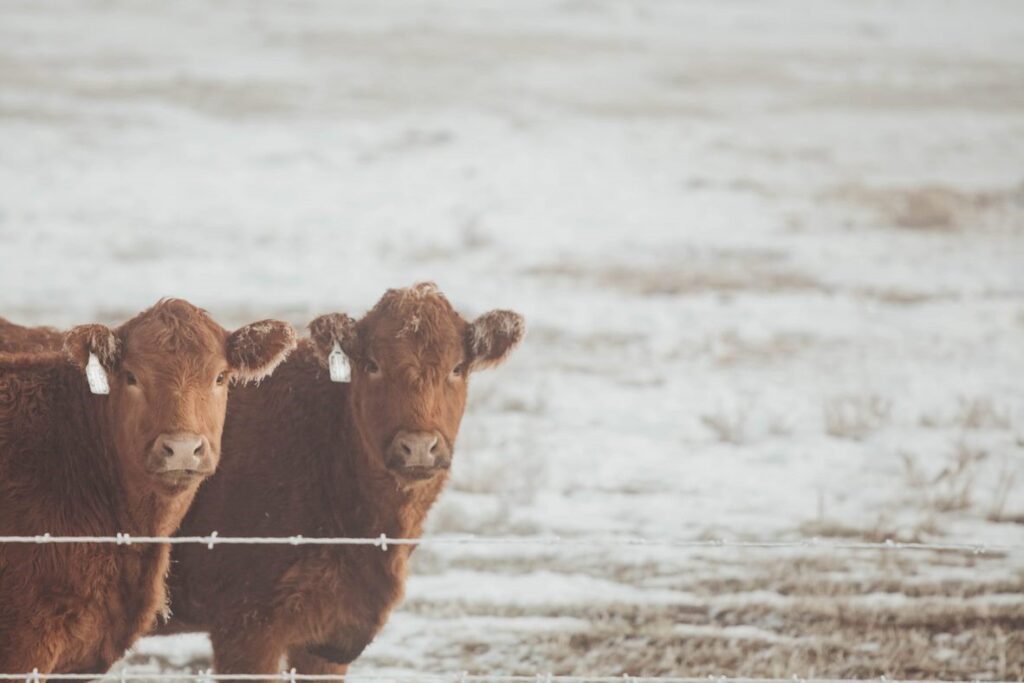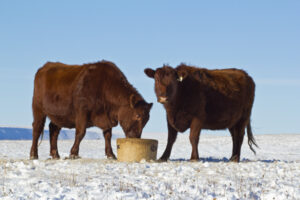Picking Replacement Heifers 🎙️
CLICK THE PLAY BUTTON TO LISTEN TO THIS ARTICLE:
This article written by Dr. Reynold Bergen, BCRC Science Director, originally appeared in the November 2022 issue of Canadian Cattlemen magazine and is reprinted on BeefResearch.ca with permission of the publisher.

Developing heifers is costly because of the feed and time involved, and margins on weaned calves are typically narrow. If it takes the first five calves for the average cow to simply pay for herself, culling her before seven years of age is clearly unprofitable. Having most of the cows wean a calf every year, for a lot of years under your management and your environment, is a key factor influencing profitability. But it’s hard to know which heifer calves will become profitable cows. The unprofitable candidates are more obvious. Heifers that are small for their age or born late in the breeding season, twinned to a bull, have obvious conformation problems, or are daughters of temperament culls are best sent to the feedlot. But who to pick from the rest?
Some producers use a closely-guarded magical equation to identify the promising heifers, and their strategy probably works just as well as their neighbor’s secret formula. Other producers cull the heifers that obviously won’t work, keep the rest, expose them to a very short breeding season, sell the open yearlings as feeders and keep the pregnant heifers.
John Basarab and Cameron Olson (University of Alberta) studied whether feed intake traits in weaned heifers can help predict their productivity as mature cows (Phenotypic and genetic correlations of beef replacement heifer feeding behaviour, feed intake and feed efficiency with cow performance and lifetime productivity; DOI: 10.1111/jbg.12522).
What They Did
This study used lifetime records from 1,145 Angus-cross heifer calves born between 2005 and 2017 at AAFC’s Lacombe Research and Development Center and the University of Alberta Roy Berg Kinsella Research Station. At both locations, weaned heifers were kept in a drylot and fed a silage-based diet through mid-May. Individual weights, backfat, feed intake and residual feed intake (feed intake adjusted for size and backfat) were measured for at least 70 days. Heifers were pastured from mid-May through October and exposed to bulls for 45 days in (late May through mid June).
At Lacombe, one group of cows was fed silage in a drylot from mid-October through April. The other group was swath-grazed from mid-October through February/March (conditions permitting), then fed in confinement through calving. All cows went to pasture in mid-May and exposed to bulls for 63 days (early June through early August). Kinsella cows remained on pasture and were supplemented with hay all winter. Cow weights and backfats were measured at the start of the breeding season, calf birth and weaning weights were collected. Heifers and cows were culled if they failed to (re)breed, lost their calf, or had poor temperament, performance, conformation or udder structure.
Each cow’s days in herd (first breeding to culling) and total lifetime productivity (total pounds of calves weaned during her lifetime) were calculated, and the relationships between her feed intake and efficiency as a heifer and subsequent performance as a cow were determined. Pedigree information was used to tease out the effect of genetics (as opposed to environment and management) on cow performance.
What They Learned
Genetics played a very minor role in determining how long the cow would stay in the herd (4%) or her total lifetime productivity (6%). That means that the environment effects and management practices accounted for the other 96% (days in herd) or 94% (total lifetime productivity).
Genetics played a larger role in feed intake (23%) and residual feed intake (43%) in heifers, so they also calculated the genetic relationships between these feed intake traits in heifers and their reproductive performance as cows. Heifers with the genetic inclination to eat more tended to stay in the herd longer (13% of the same genes influenced both traits) but became slightly heavier cows that birthed and weaned slightly bigger calves.
In contrast, heifers with the genetic inclination towards higher residual feed intake (i.e., less efficient heifers that ate more than average but didn’t grow any faster) tended to have higher lifetime productivity (14% of the same genes influenced both traits) and became somewhat fatter (but not heavier) cows, with no change in calf birth or weaning weights.
So What Does This Mean… to You?

Your environment and your management are the main things that influence cow longevity and lifetime productivity, and the two go hand in hand. It’s about doing the small things right. Things like working with a nutritionist to test the forage you grow (and occasionally your water) and supplementing as needed to ensure your herd is getting the nutrients they need to grow, maintain body condition, carry and deliver a healthy calf, produce adequate colostrum and rebreed. Things like talking to your veterinarian to make sure that your vaccination and other preventive herd health management practices are appropriate for the diseases that are common in your area.
Genetic selection – selecting your most productive cow’s daughters as replacements – is a very slow way to improve reproductive performance. Crossbreeding is the best genetic strategy to improve reproductive performance and longevity in commercial cows. Many seedstock breeders carry more than one breed. If you’ve used the same sire breed for a few generations, a reputable breeder can help you identify a crossbreeding option that will be a profitable fit for your genetics, environment and management.
The Beef Cattle Research Council is funded by the Canadian Beef Cattle Check-Off. The BCRC partners with Agriculture and Agri-Food Canada, provincial beef industry groups and governments to advance research and technology transfer supporting the Canadian beef industry’s vision to be recognized as a preferred supplier of healthy, high-quality beef, cattle and genetics.
Click here to subscribe to the BCRC Blog and receive email notifications when new content is posted.
The sharing or reprinting of BCRC Blog articles is typically welcome and encouraged, however this article requires permission of the original publisher.
We welcome your questions, comments and suggestions. Contact us directly or generate public discussion by posting your thoughts below.